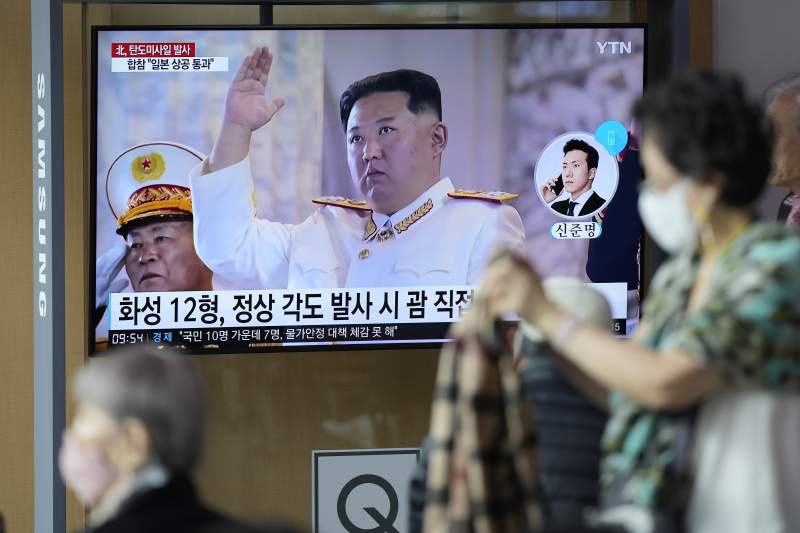
A TV screen showing a news program reporting about North Korea’s missile launch with file footage of North Korean leader Kim Jong Un, is seen at the Seoul Railway Station in Seoul on Tuesday.
8:53 JST, October 6, 2022
SEOUL/TOKYO (Reuters) – North Korea fired two short-range ballistic missile toward its east coast on Thursday in the direction of Japan, following joint South Korean and U.S. missile drills and the return of a U.S. aircraft carrier to the region in response to the North’s recent missile tests.
The missile launch was the sixth in 12 days and the first since North Korea fired an intermediate-range missile (IRBM) over Japan on Tuesday.
The launch was reported by South Korea’s Joint Chiefs of Staff and the Japanese government.
This is the sixth time in the short period just counting the ones from the end of September, Japanese Prime Minister Fumio Kishida told reporters. “This absolutely cannot be tolerated.”
The launch came about an hour after North Korea condemned the United States for talking to the United Nations Security Council about Pyongyang’s “just counteraction measures of the Korean People’s Army on south Korea-U.S. joint drills.”
In a statement released by the reclusive nation’s foreign ministry, North Korea also condemned Washington for repositioning a U.S. aircraft carrier in the waters off the Korean peninsula, saying it posed a serious threat to the stability of the situation.
The USS Ronald Reagan and its strike group of accompanying warships was abruptly redeployed after South Korea and the U.S. military conducted rare missile drills east of North Korea. This comes in response to North Korea’s IRBM launch over Japan this week, one of the allies’ sharpest reactions since 2017 to a North Korean weapon test.
The United States accused China and Russia on Wednesday of enabling North Korean leader Kim Jong Un by blocking attempts to strengthen U.N. Security Council sanctions on Pyongyang over its nuclear weapons and ballistic missile programs.
Tokyo lodged a “vehement protest” with North Korea through delegations in Beijing, Japanese Defense Minister Yasukazu Hamada said.
The first missile on Thursday likely flew to an altitude of about 100 km and a range of 350 km, while the second one had an estimated altitude of 50 kilometers (31.07 miles) and covered 800 km, likely flying in an irregular trajectory, he said.
Many of North Korea’s most recent short-range ballistic missiles (SRBMs) are designed to fly on a lower, depressed trajectory and potentially maneuver, complicating efforts to detect and intercept them.
North Korea has relentlessly and unilaterally escalated its provocation especially since the beginning of this year, Hamada told reporters.
South Korea’s JCS said the missiles were launched from near the North Korean capital of Pyongyang.
"World" POPULAR ARTICLE
-

8 Japanese Nationals Stranded on Indonesia’s Sumatra Island
-

U.S. Senate Resolution Backs Japan, Condemns China’s Pressure
-

Mozambican Cooking Class Held in Matsuyama, Ehime Pref.; Participants Don Aprons, Bandanas Made from Traditional Mozambique Fabric
-

China to Impose Sanctions on Shigeru Iwasaki, Former Head of Japan’s Self-Defense Forces, Who Serves as Adviser to Taiwan’s Executive Branch
-

South Korea’s Top Court Dismisses Nippon Steel Appeal in Lawsuit over Requisitioned Worker
JN ACCESS RANKING
-

Tokyo Economic Security Forum to Hold Inaugural Meeting Amid Tense Global Environment
-

Keidanren Chairman Yoshinobu Tsutsui Visits Kashiwazaki-Kariwa Nuclear Power Plant; Inspects New Emergency Safety System
-

Imports of Rare Earths from China Facing Delays, May Be Caused by Deterioration of Japan-China Relations
-

University of Tokyo Professor Discusses Japanese Economic Security in Interview Ahead of Forum
-

Japan Pulls out of Vietnam Nuclear Project, Complicating Hanoi’s Power Plans






















